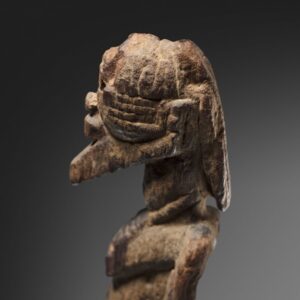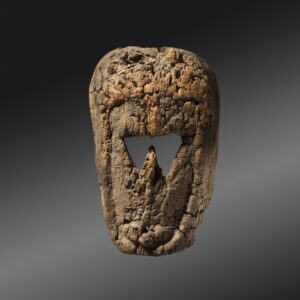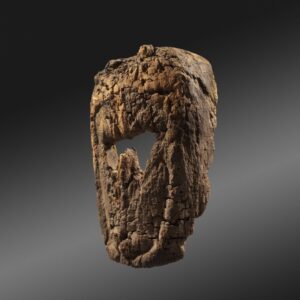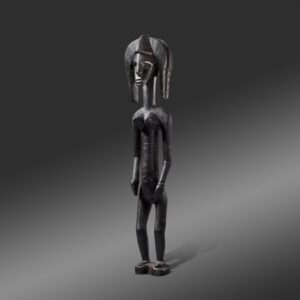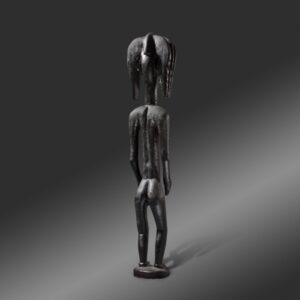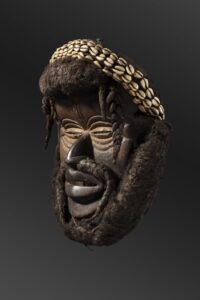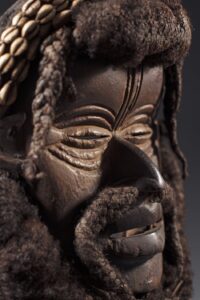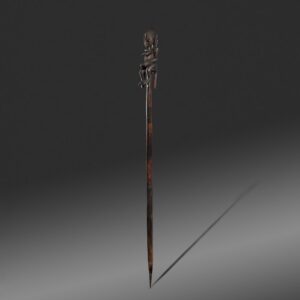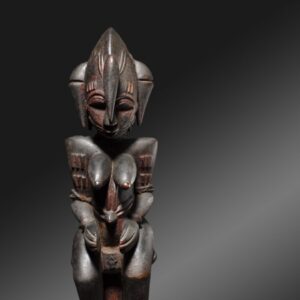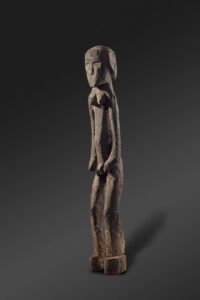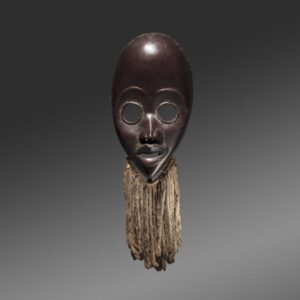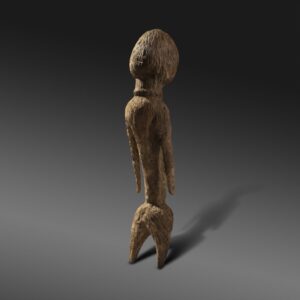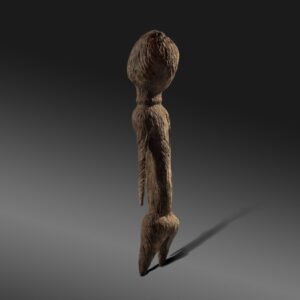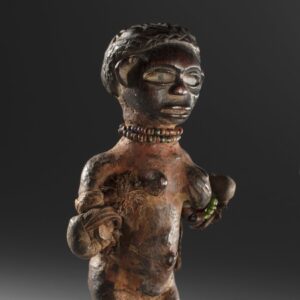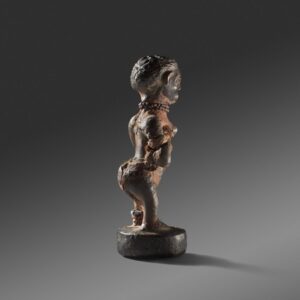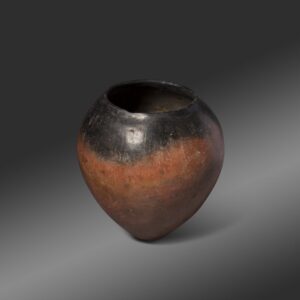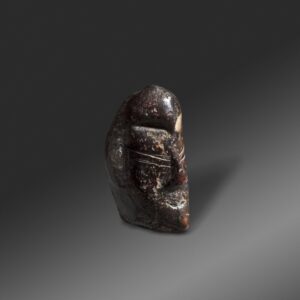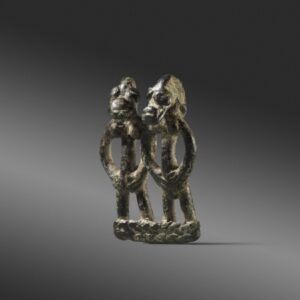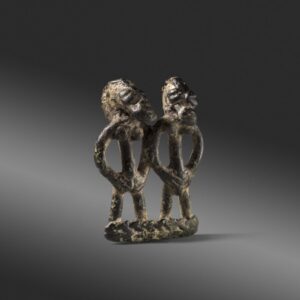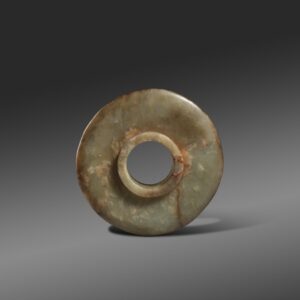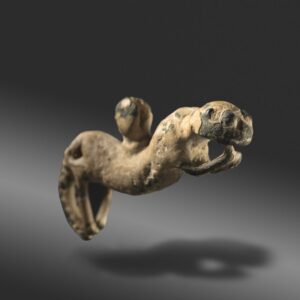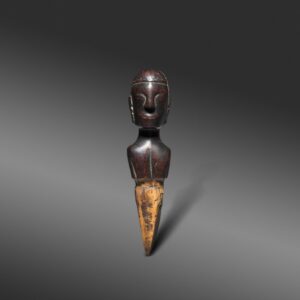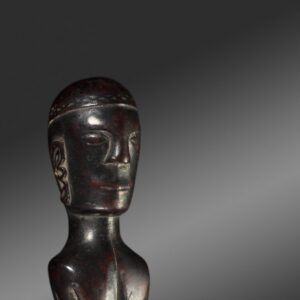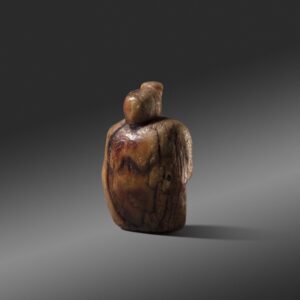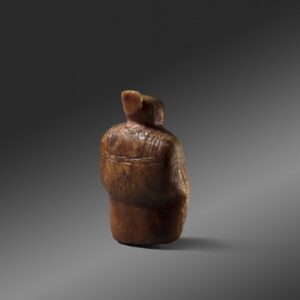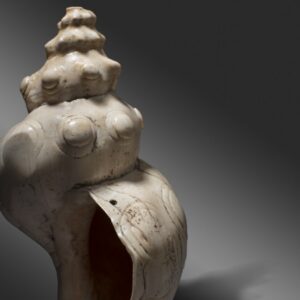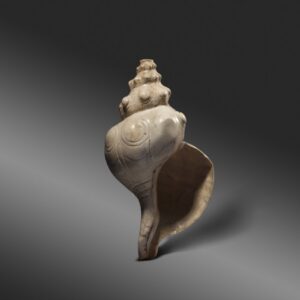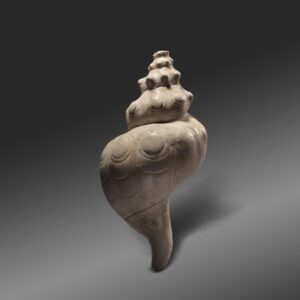Tellem mask
Tellem people, Mali
15th Century
23 cm
Wood
Provenance:
Christine Valluet, Paris
Publication:
Au delà du Masque. Schoffel de Fabry. Paris. Fig. 24.
Bambara figure
Bambara people, Mali
19th Century
48 cm
Wood
Provenance:
Private collection, USA
Grebo mask
Grebo people, Liberia
19th Century
26 cm
Wood, fiber, shell, hair
Provenance:
Vittorio Mangio collection, Italy
Javier Lentini collection, Spain
Tefalipitya ceremonial staff
Senufo people, Ivory Coast
19th Century
136 cm
Wood
Provenance:
Vente Loudmer, Paris (1980)
Alexis Brimaud collection, Lisboa
Karaboro statue
Karaboro people, Ivory Coast
19th Century
63 cm
Wood
Provenance:
Galerie Olivier Castellano, Paris
Private collection, Paris
Dan mask
Dan people, Ivory Coast
19th Century
23,5 cm (without the bear)
Wood, iron, woven cotton beard and pigments
Provenance:
Nadine Vinot-Postry, Paris
Bernard Dulon, Paris
Moba figure
Mona people, Togo
19th Century or before
67 cm
Wood
Provenance:
Galerie Majestic, Paris
Private collection, Paris
Vili figure
Vili people, Democratic Republic of the Congo
19th Century
14,5 cm
Wood, fabric, beads, glass
Provenance:
Galerie Monbrison, Paris
Alberto Costa Romero de Tejada collection, Spain
Javier Lentini collection, Spain
Publication:
El primer Eros. Barcelona, 2004. nº 4. p. 44
Luba figure
Luba people, Democratic Republic of the Congo
19th Century
13,5 cm
Wood, beads
Provenance:
Pierre Dartevelle collection, Brussels
Guy van Rijn collection, Amsterdam
Michael Koenig collection, Belgium
CURIOSITIES
A head of an idol
Early Cycladic II, 2600 – 2500 BC
10,2 cm
Marble
Provenance:
N. Koutoulakis, Switzerland, 1960’s
Thence by descent in the family
Private collection, Belgium, 1990
Private collection, USA
The head of a Cycladic idol, an Early Spedos type. The face is convex in profile when viewed from the front, with notably oval-shaped cheeks. The forehead is flattened horizontally at the crown and slopes downward to the pronounced long, vertical nose. The back of the head is smooth and vertical.
Ancient Egyptian predynastic black-topped pottery jar
Naqada I-II, C. 3900 – 3300 B.C
14 cm
Provenance:
Private collection, UK
Thence by descent
Fired ceramic, of ovoid from with tapering base and rounded lip, characteristic red slip coating with blackened rim and upper body.
Head
Okvik or Old Bering Sea I
Circa 100 – 400 AD
4 cm
Ivory
Provenance:
Jeffrey Meyer collection, New York
Ancient art unearthed at Okvik sites in the Arctic include figures carved from walrus ivory in the form of stylized humans. Little is known about their creators, but most of such figurines have been found in high-status burials with hunting paraphernalia and other ritual objects.
Senufo couple figure
Senufo people, Ivory Coast
19th Century
4 cm
Provenance:
Private collection, France
One of the finest quality of miniature works is made through the casting of metal, a tradition developed in West Africa. A lot of objects made pf precious metal or copper alloys have been created in this area: figurative pendants, anthropomorphic and zoomorphic amulets, ornaments, etc. Although the shapes may vary, the common denominator of these pieces is their very small size, as well s the care for detail showing the great technical mastery of the area’s founders.
Chinese Archaic Jade Bi
Sung-Yan Dynasty, China
10th – 12th a. C
10 cm
Provenance:
Metropolitan Museum of Art, New York, 1983
Leonard Loeb collection, New York, 1988
Carved brown-green jade “Bi”, a type of circular Chinese jade artifact which originated in the Neolithic period (3400 – 2250 B.C). Most are undecorated while disks from later periods have ornate surface carvings. The circular form represents heaven and was among the earliest religious symbols. The original function and significance of the bi disk is unknown because the Neolithic cultures have left no written history.
Zoomorphic figure
Voltaic precos, West Africa
19th Century or before
4 x 8,5 cm
Bronze
Provenance:
Patrick Girard collection, Lyon
Numerous studies place the origins of these artisan founders in the inland Niger delta. Archaic Voltaic objects can be dated between the first third of the 18th century and the end of the 19th century.
Batak lime squeezer
Sumatra, Indonesia
19th Century
13,5 cm
Wood
Provenance:
Dr. Javier Lentini Marugán collection, Spain
Javier Lentini collection, Spain
This wooden implement is a ritual lime squeezer that depicts a standing human figure. The face is intricately carved with fine, angular features. The wood is highly polished, perhaps from the repeated turning required to extract lime juice. A ritual specialist used lime in several ceremonial contexts.
Kulai Anthropomorphic Amulet with face markings
Siberia, Ob’ River Region
Kulai or Ust Puli culture
3rd Century BC – 2nd Century A.D
12 cm
Bronze
Provenance:
Private collection, Spain
Long ago, a mysterious civilization left its mark on the Ob River in western Siberia: the Kulai culture, which developed between the 5th century BC and the 5th century AD.
The Kulai were known to be skilled with bronze and probably in the art of tattooing. Intertwined with their spirituality, both traditions combined to form remarkable works of art.
Amamassalik effigy
Greenland or Eastern Canada
Second half of the Thule Period (circa. 1500 A.D)
Mineralized walrus tusk
5,2 cm
Provenance:
Unidentified Canadian geologist
Jean-Paul Agogue collection, Paris
Galerie Alain Bovis, Paris
Alexander Bernand collection, Paris / London
A stylized female figure wearing the typical Ammassalik topknot. The figure shows long incised tattoo lines on the shoulders and dorsal region.
Sea shell
Maya culture, Mexico or Guatemala
200 – 800 A.D
39,5 cm x 20,3 cm
Provenance:
Jean Louis Sonnery collection
Ed Merrin collection, New York
Large shell carved in rough relief with three progressively larger registers of high-relief circles surrounded by two incised circles, themselves set in vertical registers incised with scrolls. There is a hole at the bottom to hold it around the neck by means of a tie. This type of work, typical of the Maya, was used as a trumpet during religious ceremonies. A rare piece in its corpus.

